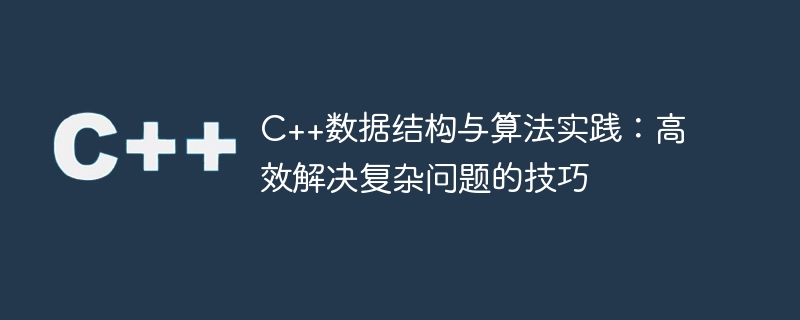

C is a very powerful programming language that can not only be used to develop various applications, but can also be used to solve various complex problems. Data structures and algorithms are a very important part of C programming. By rationally selecting data structures and applying appropriate algorithms, we can achieve efficient problem solutions. This article will introduce some practical skills of C data structures and algorithms to help readers better understand and apply them.
1. Choose the appropriate data structure
When solving a problem, you must first clarify the characteristics and requirements of the problem, and then choose an appropriate data structure to store and process the data. Common data structures include arrays, linked lists, stacks, queues, heaps, trees, graphs, etc. Each data structure has its own characteristics and applicable scenarios.
For example, for scenarios that require frequent insertion and deletion, you can choose dynamic data structures such as linked lists or trees; for scenarios that require fast search and sorting, you can choose static data structures such as arrays or hash tables.
2. Flexible use of basic algorithms
In C, there are many classic algorithms that can help us solve various problems, such as sorting algorithms, search algorithms, graph algorithms, etc. These algorithms have been widely studied and optimized, and we can directly use them to improve problem solving efficiency.
For example, for problems that require sorting a set of data, you can use common sorting algorithms such as quick sort, merge sort, or heap sort; for problems that require quickly finding an element in an ordered array , you can use efficient search algorithms such as binary search.
3. Thinking about the nature and characteristics of the problem
When solving a problem, we must think deeply about the nature and characteristics of the problem and understand the logic and rules behind the problem. This can help us design more efficient algorithms and data structures, and solve problems at their root rather than resorting to less elegant ad hoc solutions.
For example, for a string matching problem, you can first analyze the characteristics and rules of the string, and then design an efficient matching algorithm; for a graph traversal problem, you can analyze the structure and characteristics of the graph, and based on The problem requires choosing an appropriate traversal algorithm.
4. Utilize existing open source libraries and frameworks
In C programming, there are many excellent open source libraries and frameworks that can help us speed up development and improve problem-solving efficiency. These libraries and frameworks have been extensively and deeply tested and optimized to help us avoid reinventing the wheel.
For example, STL (Standard Template Library) provides many commonly used data structures and algorithms, which can be used directly, such as vector, list, map, etc.; the Boost library provides many efficient algorithms and tools, such as multi-threading Programming, network programming, etc.
5. Pay attention to the space and time complexity
When solving problems, pay attention to the space and time complexity of the algorithm. Space complexity refers to the memory space required by the algorithm, while time complexity refers to the execution time required by the algorithm. Typically, we want the space and time complexity of an algorithm to be as low as possible.
By rationally selecting data structures and optimization algorithms, the space and time complexity of the algorithm can be reduced. This can improve the execution efficiency of the algorithm and solve problems faster while ensuring the correctness of the algorithm.
To sum up, the practical skills of C data structures and algorithms are the key to solving complex problems. By choosing appropriate data structures, using basic algorithms flexibly, thinking deeply about the nature and characteristics of the problem, using existing open source libraries and frameworks, and paying attention to space and time complexity, we can design C programs that efficiently solve complex problems. Through continuous learning and practice, we can continuously improve our programming abilities and solve more complex and challenging problems.
The above is the detailed content of C++ Data Structure and Algorithm Practice: Techniques for Efficiently Solving Complex Problems. For more information, please follow other related articles on the PHP Chinese website!
 Page replacement algorithm
Page replacement algorithm
 Usage of treenode
Usage of treenode
 What are the differences between c++ and c language
What are the differences between c++ and c language
 Recommended learning order for c++ and python
Recommended learning order for c++ and python
 Cost-effectiveness analysis of learning python and c++
Cost-effectiveness analysis of learning python and c++
 Is c language the same as c++?
Is c language the same as c++?
 Which is better to learn first, c language or c++?
Which is better to learn first, c language or c++?
 The difference and connection between c language and c++
The difference and connection between c language and c++




